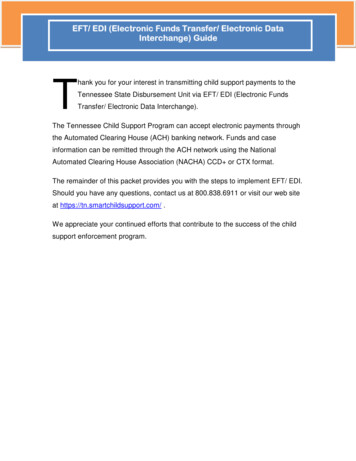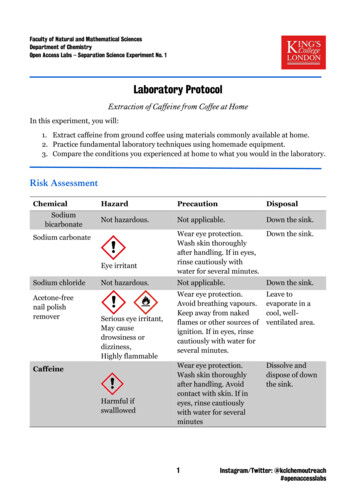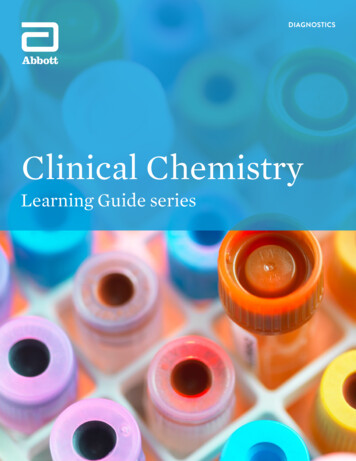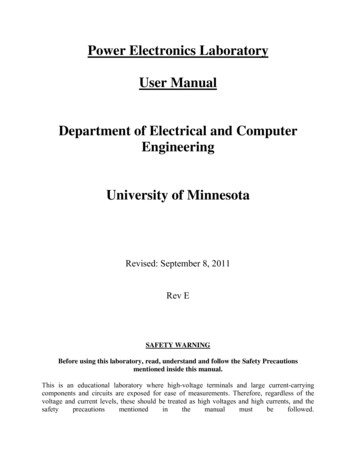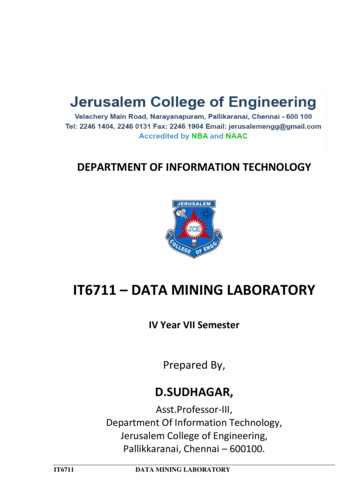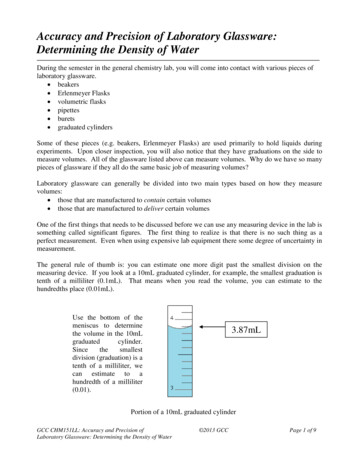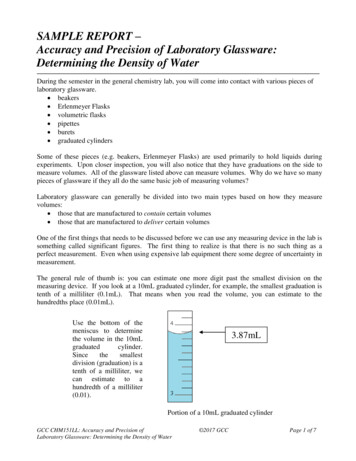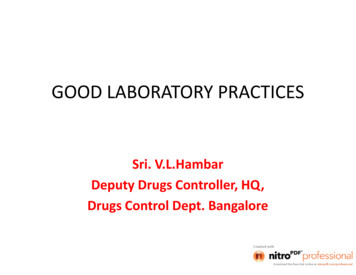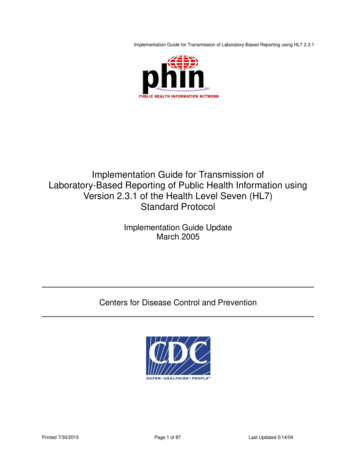
Transcription
Implementation Guide for Transmission of Laboratory-Based Reporting using HL7 2.3.1Implementation Guide for Transmission ofLaboratory-Based Reporting of Public Health Information usingVersion 2.3.1 of the Health Level Seven (HL7)Standard ProtocolImplementation Guide UpdateMarch 2005Centers for Disease Control and PreventionPrinted 7/30/2015Page 1 of 87Last Updated 5/14/04
Implementation Guide for Transmission of Laboratory-Based Reporting using HL7 2.3.1Table of Contents1Introduction. 31.11.21.31.42HL7 Concepts . 52.12.22.32.42.533.23.3MESSAGE CONTROL SEGMENTS . 103.1.1 Message Header (MSH) Segment . 10PATIENT ADMINISTRATION MESSAGE SEGMENTS . 163.2.1 Patient Identification (PID) Segment . 163.2.2 Next of Kin/Associated Parties (NK1) Segment. 25SEGMENTS COMMON TO ALL ORDERS. 333.3.1 Common Order (ORC) Segment . 333.3.2 Observation Request Segment (OBR) . 403.3.3 Observation/Result (OBX) Segment. . 543.3.4 Notes and Comments (NTE) segment . 64HL7 Batch Protocol . 654.14.24.3567HL7 Definitions . 5Basic Message Construction Rules . 6Unsolicited Observation Message (ORU)/ Event R01 . 7HL7 Standard Segment Usage . 8Segment Attribute Table Abbreviations . 9Segment Definitions . 103.14Background . 3HIPAA . 3Scope . 4Contacts . 4HL7 batch file structure . 65Acknowledging Batches . 65Batch Segments . .664.3.1 File Header (FHS) Segment . 664.3.2 File Trailer (FTS) . 674.3.3 Batch Header (BHS) Segment . 674.3.4 Batch Trailer (BTS) Segment . 68APPENDIX A. HL7 Examples of Report Messages . 69APPENDIX B: Code Tables . 70APPENDIX C: Data Types used in this Implementation . 82Printed 7/30/2015Page 2 of 87Last Updated 7/30/2015
Implementation Guide for Transmission of Laboratory-Based Reporting using HL7 2.3.11 Introduction1.1 BackgroundMonitoring the occurrence of diseases is a cornerstone of public health decision-making. This monitoring,referred to as public health surveillance, can be used to trigger case or outbreak investigations, followtrends, evaluate the effect of prevention measures such as immunizations, and suggest public healthpriorities. Because disease trends have the potential to shift rapidly, especially with infectious diseases,surveillance needs to be ongoing, timely, and complete.Each state and territory has requirements for laboratories to report certain findings to health officials. Inthe past, these reports were written by hand on forms provided by health departments and mailed toappropriate offices. With computerization of laboratories, it has become possible for laboratories to sendreportable data to health departments electronically.This guide contains the specifications for sending laboratory-reportable findings to appropriate state,territorial, and federal health agencies using Health Level Seven (HL7) messages. The message is notspecific to any pathogen or reportable condition and is applicable for most laboratory-reportable findingsin the National Public Health Surveillance System (NPHSS) as defined by the Council of State andTerritorial Epidemiologists (CSTE).This document is a guide for electronic communication of reportable diseases, consistent withrecommended reporting of reportable conditions from laboratories to public health agencies using HL7Version 2.3.1. The implementation guide follows the specifications described in the HL7 Standard Version2.3.1 and focuses on one type of HL7 message, the Observational Report - Unsolicited (ORU). HL7describes the order and structure of data fields for sharing test results, but does not stipulate whichcoding system or dictionary of descriptive terms should be used to identify specific tests and findingsunambiguously; this is determined by agreement of the parties sharing the information. For sharinglaboratory-based reports of public health findings, these coding systems are recommended: 1) LogicalObservation Identifier Names and Codes (LOINC ) for specific laboratory procedure names, 2) theSystematized Nomenclature for Human and Veterinary Medicine (SNOMED ) for descriptions of findings,notably organism names, and 3) International Classification of Diseases, Clinical Modification (ICD-9-CM)coding system to code signs, symptoms, injuries, diseases, and conditions. The guide gives a descriptionof the utility and requirement of each data field in the ORU message, provides examples of completemessages, and includes tables of recommended codes.1.2 HIPAAThe Health Insurance Portability and Accountability Act (HIPAA, or the Act), P.L. 104-191, was enacted onAugust 21, 1996. The Act included provisions relating to insurance coverage, but it also included asection that is relevant to electronic reporting of health care information. Among the requirements in thissection called administrative simplification were: the adoption of standards for electronic healthinformation transactions for certain uniform financial and administrative transactions and data elements,including claims, enrollment, eligibility, payment, coordination of benefits, and for the security of electronichealth information systems. HIPAA also addressed safeguards of information, electronic signatures, andstandards for various unique health identifiers, and specific code sets to be used in the transactions.HIPAA also included provisions for adopting standards for the privacy of health information. The Law preempts State laws and imposes civil money penalties and prison for certain violations and made somechanges in the membership and duties of the National Committee on Vital and Health Statistics (NCVHS).There is also a provision that NCVHS will make recommendations and legislative proposals to theSecretary on the adoption of uniform data standards for patient medical record information and theelectronic exchange of such information. It also addresses state regulatory reporting by stating,"[N]othing in this part shall limit the ability of a State to require a health plan to report, or to provide accessto, information for management audits, financial audits, program monitoring and evaluation, facilitylicensure or certification, or individual licensure or certification." Regulations issued under the Act providethe implementation detail.Printed 7/30/2015Page 3 of 87Last Updated 7/30/2015
Implementation Guide for Transmission of Laboratory-Based Reporting using HL7 2.3.1On the issue of public health, HIPAA states, "Nothing in this part shall be construed to invalidate or limitthe authority, power, or procedures established under any law providing for the reporting of disease orinjury, child abuse, birth, or death, public health surveillance, or public health investigation orintervention."The covered entities (those who have to comply) named in the HIPAA legislation are "health plans, healthcare clearinghouses, and health care providers who transmit any health information in electronic form inconnection with a transaction referred to in Section 1173(a) of the Act.” The transactions listed in Section1173(a) specifically deal with eligibility, enrollment, claims, and others related to payment of insuranceclaims. Many of the public health reports will occur between parties that are not covered entities underthe Act and do not involve the covered transactions, because public health agencies generally do not fileinsurance claims. The regulation implementing the HIPAA privacy provisions allowed public healthexemptions for disclosure without patient consent of individually identifiable health information for thepurposes quoted above.Public health reporting is not a part of the claims process and conceptually is most closely aligned withthe patient medical record, with Health Level Seven (HL7) as a recognized standards developmentorganization in that subject area. We do not believe the HIPAA requirements related to electronictransactions will in any way affect our planned use of HL7 for electronic laboratory reporting. The HL7message as defined in this document was carefully developed to provide a method for evidence ofreportable conditions to be transmitted electronically. We believe that laboratories can report this publichealth information using the HL7 standard as described here and that these reports will not be altered byHIPAA provisions.1.3 ScopeThe specifications in this guide are not intended as a tutorial for either HL7 or interfacing in general. Thereader is expected to have a basic understanding of interface concepts, HL7, and electronic laboratorybased reporting of public health information. This guide describes a data exchange protocol applicable forreporting most diseases of public health importance.This implementation guide is based on and consistent with the HL7 Standard, Version 2.3.1. Any userdefined variations from the standard are clearly described. Reporting requirements for reportablediseases may vary by state. Electronic copies of this document are available.1.4 ContactsHL7 ContactFor information about HL7, contact:Health Level Seven3300 Washtenaw Avenue, Suite 227Ann Arbor, MI 48104-4250Phone: (734) 677-7777Fax:(734) 677-6622E-Mail: hq@hl7.orgWebsite: www.hl7.orgContact for this GuideFor information about this Guide, contact:Katherine RobinsonTel: (404)202-6247Fax: (912)635-3565Email: krobinson@cdc.govMary Hamilton(404) 371-5362Margaret Marshburn (404) 371-5352Centers for Disease Control and PreventionAtlanta, GA 30333: Website: www.cdc.gov/phin/messagingPrinted 7/30/2015Page 4 of 87Last Updated 7/30/2015
Implementation Guide for Transmission of Laboratory-Based Reporting using HL7 2.3.12 HL7 ConceptsThis project remains true to the HL7 2.3.1 Final Standard, dated May, 1999. The entries below arederived from that standard for use with Electronic Laboratory Reporting.2.1 HL7 DefinitionsMessage: A message is the entire unit of data transferred between systems in a single transmission. Itis a series of segments in a defined sequence, with a message type and a trigger event. Between textmessages in a batch, the hex characters 0D0A0D0A represent the end of each message.Segment: A segment is a logical grouping of data fields. Segments within a defined message may berequired or optional, may occur only once, or may be allowed to repeat. Each segment is named and isidentified by a segment ID, a unique 3-character code. The hex characters ‘ 0D0A’ that act as a SegmentTerminator (equivalent to a Carriage Return and Line Feed) denote the end of each segment.Field: A field is a string of characters. Each field is identified by the segment it is in and the positionwithin the segment; e.g., PID-5 is the fifth field of the PID segment. Optional data fields need not bevalued. Whether a field is required, optional, or conditional in a segment is specified in the segmentattribute tables. The designations are: R Required, O Optional, C Conditional on the trigger event oron some other field(s). The field definition should define any conditionality for the field: X Not Supportedwith this trigger event, B Left in for backward compatibility with previous versions of HL7. A maximumlength of the field is stated as normative information. Exceeding the listed length should not beconsidered an error.Component: A component is one of a logical grouping of items that comprise the contents of a coded orcomposite field. Within a field having several components, not all components are required to be valued.Examples in this guide demonstrate both fully valued and partially valued coded and composite fields.Item number: Each field is assigned a unique item number. Fields that are used in more than onesegment will retain their unique item number across segments.Null and empty fields: The null value is transmitted as two double quote marks (""). A null-valued fielddiffers from an empty field. An empty field should not overwrite previously entered data in the field. Thenull value means that any previous value in this field should be overwritten.Data type: A data type restricts the contents and format of the data field. Data types are given a 2- or 3letter code. Some data types are coded or composite types with several components. The applicabledata type is listed and defined in each field definition. Appendix D provides a complete listing of datatypes used in this document and their definitions.Delimiters: The delimiter values are given in MSH-2 and used throughout the message. Applicationsmust use agreed upon delimiters to parse the message. The recommended delimiters for laboratorymessages are ‘0D0A’ Segment Terminator (hex characters equivalent to a Carriage Return and LineFeed); Field Separator; Component Separator; & Sub-Component Separator; RepetitionSeparator; and \ Escape Character.Message syntax: The abstract message is defined in special notation that lists the 3-letter segmentidentifiers in the order they will appear in the message. Braces, {}, indicate that one or more of theenclosed group of segments may repeat, and brackets, [ ], indicate that the enclosed group of segmentsis optional.Trigger events: The HL7 Standard is written from the assumption that an event in the real world ofhealthcare creates the need for data to flow among systems. The real-world event is called the triggerevent. For example, the trigger event a patient is admitted may cause the need for data about thatpatient to be sent to a number of other systems. The trigger event, an observation (e.g., a CBC result) fora patient is available, may cause the need for that observation to be sent to a number of other systems.Printed 7/30/2015Page 5 of 87Last Updated 7/30/2015
Implementation Guide for Transmission of Laboratory-Based Reporting using HL7 2.3.1When the transfer of information is initiated by the application system that deals with the triggering event,the transaction is termed an unsolicited update.Z segments: All message types, trigger event codes, and segment ID codes beginning with Z arereserved for locally defined messages. No such codes are defined within the HL7 Standard. In thisGuide are references to a legacy z-segment that is sent in the 2.3.z ELR messages designed before the2.3.1 standard included a place to capture the Ordering Facility Name, Address and Phone Number, aswell as the Ordering Provider’s address. These fields are sent in the ZLR segment from someparticipating Laboratories and converted to this 2.3.1 message format. That ZLR segment also containsNext of Kin information that is translated to a NK1 segment, and may contain a Reported Patient Age fieldthat is converted to an OBR/OBX pair that uses the LOINC code for Reported Patient Age for 2.3.1Electronic Laboratory Reporting.2.2 Basic Message Construction RulesEncoding Rules for Sending- Encode each segment in the order specified in the abstract message format.- Place the Segment ID first in the segment.- Precede each data field with the field separator.- Encode the data fields in the order and data type specified in the segment definition table.- End each segment with the segment terminator.- Components, subcomponents, or repetitions that are not valued at the end of a field need not berepresented by component separators. The data fields below, for example, are equivalent: XXX&YYY&& is equal to XXX&YYY ABC DEF is equal to ABC DEF Encoding Rules for Receiving- If a data segment that is expected is not included, treat it as if all data fields within were not present.- If a data segment is included that is not expected, ignore it; this is not an error.- If data fields are found at the end of a data segment that are not expected, ignore them; this is not anerror.Printed 7/30/2015Page 6 of 87Last Updated 7/30/2015
Implementation Guide for Transmission of Laboratory-Based Reporting using HL7 2.3.12.3 Unsolicited Observation Message (ORU)/ Event R01Laboratory information is reported through the ORU R01 message to public health agencies. Thesupported segments and usage for Public Health ORU/R01 message structure are described below.ORU - unsolicited transmission of an observation message (event R01)ORU R01MSHPIDNK1ORC{OBR{[OBX]{ [NTE] }Observational Results (Unsolicited)Message Header segmentPatient Identification segmentNext-Of-Kin segmentOrder common segmentChapter2334Observations Report ID segment7Observation/Result segmentNotes and comments segment72}}Using the basic “building blocks” of MSH, PID, OBR and OBX segments (in bold type in table above), aclinical report can be constructed as a three-level hierarchy with the patient information (PID) segment atthe upper level, one or more order records (OBR) at the next level, and one or more observation records(OBX) at the bottom. The Message Header (MSH) segment is required for all HL7 messages. The Nextof Kin (NK1) segment can provide information about parties associated with the patient. The commonorder (ORC) segment transmits fields common to all types of requested services, and the notes andcomments (NTE) segment is only supported at the Result level for ELR.While certain elements of the message are required for laboratory-based reporting, data in non-requiredfields will not be rejected. The standard ORU message allows for the optional use of PD1, PV1, PV2,CTI, and DSC segments, but these segments are not defined or used in the laboratory-based reportingmessage. For this reason, t
Printed 7/30/2015 Page 3 of 87 Last Updated 7/30/2015 . 1 Introduction . 1.1 Background . Monitoring the occurrence of di

